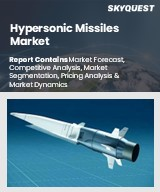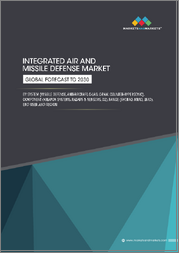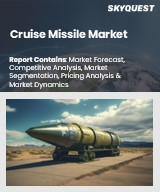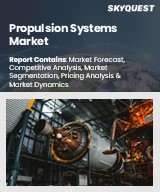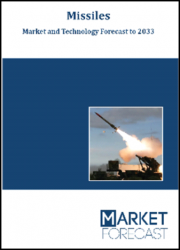
|
시장보고서
상품코드
1844306
미사일 추진 시스템 시장 : 시장 기회, 성장 촉진요인, 산업 동향 분석, 예측(2025-2034년)Missile Propulsion Systems Market Opportunity, Growth Drivers, Industry Trend Analysis, and Forecast 2025 - 2034 |
||||||
세계의 미사일 추진 시스템 시장은 2024년에 48억 달러로 평가되었고, CAGR 7.5%로 성장할 전망이며, 2034년에는 98억 달러에 이를 것으로 예측됩니다.

이 확대에는 세계적인 국방 지출 증가, 지정학적 긴장 증가, 전략적 군사 현대화 추진 등 여러 요인이 기여하고 있습니다. 또한 우주 개발 산업의 성장과 위성 발사의 급증이 고도 추진 시스템 수요를 끌어 올리고 있습니다. 군사 기술이 진보함에 따라 고성능 추진 솔루션, 특히 극초음속과 고기동을 가능하게 하는 솔루션에 대한 요구도 커지고 있습니다. 인공지능(AI)과 스마트 타겟팅 시스템의 통합도 미사일 기술을 재구성하고 있으며, 군사력은 미사일 공격의 정확성과 유연성을 높이기 위해 AI 의존성을 강화하고 있습니다. 이 추세는 2025년부터 2030년 사이에 봉우리를 맞이하여 보다 정확하고 적응성이 높은 미사일을 통해 현대 전쟁에 혁명을 가져올 것으로 예측됩니다.
| 시장 범위 | |
|---|---|
| 시작 연도 | 2024년 |
| 예측 연도 | 2025-2034년 |
| 시장 규모 | 48억 달러 |
| 예측 금액 | 98억 달러 |
| CAGR | 7.5% |
탄도 미사일 분야의 2024년 시장 규모는 26억 달러였습니다. 이 분야는 지정학적 불안정이 계속되고 있어 장거리 정밀 공격 능력 수요가 높아지고 있기 때문에 이익을 얻고 있습니다. 각국은 보다 우수한 속도, 정밀도, 사거리를 확보하기 위해 미사일 무기 업그레이드에 많은 투자를 하고 있습니다. 이 때문에 연료 효율, 모듈의 유연성, 정밀 타격 능력을 높이는 선진 추진 기술의 개발이 요구되고 있습니다.
지상 배치형 미사일 시스템 분야는 이동 및 배포 가능한 미사일 시스템에 대한 수요 증가에 의해 2024년에는 21억 달러로 평가되었습니다. 영토 방위 및 신속한 대응 능력에 중점을 두게 되어, 군부는 이러한 요구를 충족시키기 위한 고급 추진 솔루션을 요구하게 되었습니다. 제조업체는 변화하는 전장 요구 사항에 적응하기 때문에 기동성 강화, 추진 효율성 향상 및 고급 조준 시스템 구축에 주력해야 합니다.
미국의 미사일 추진 시스템 미국은 미사일 기술 연구 및 극초음속 추진 시스템 개발에 많은 투자가 가능한 많은 국방 예산을 배경으로 2024년 15억 달러를 창출했습니다. 미국은 또한 군사 자산의 현대화를 선호하고 있으며, 이는 보다 고도로 효율적인 미사일 추진 기술의 개발을 포함합니다. 이에 따라 제조업체 각사는 극초음속 추진에 있어서 기술 혁신을 가속시키는 한편, 방위 기관과 전략적 파트너십을 맺어 진화하는 기술적 수요에 대응하고 있습니다.
세계 미사일 추진 시스템 산업에서 유명한 기업으로는 Lockheed Martin Corporation, Raytheon Technologies, Northrop Grumman, Rolls-Royce plc, Hanwha Aerospace, Kratos, Moog Inc., AVIO SPA, EDePRo, MBDA, IHI Corporation, Karman Space & Defense, Nammo AS, L3Harris Technologies, Inc., RAFAEL Advanced Defense Systems, Roxel, Vaya Space, and Walchandnagar Industries Limited 등이 있습니다. 미사일 추진 시스템 시장에서의 지위를 유지 및 강화하기 위해, 각사는 최첨단 기술의 진보와 전략적 제휴를 중시하고 있습니다. 대부분은 속도와 정밀도에 대한 군사적 요구에 부응하기 위해 극초음속 기술을 통합한 차세대 추진 시스템의 개발에 주력하고 있습니다. 또한 제조업체는 미사일 조준과 유연성을 향상시키기 위해 AI와 스마트 시스템의 통합에 많은 투자를 하고 있습니다. 방위 기관과의 제휴도 중요하며, 이에 따라 기업은 군사적 요구와 밀접한 연계를 유지하고 정부와의 계약으로부터 이익을 얻을 수 있습니다.
목차
제1장 조사 방법 및 범위
제2장 주요 요약
제3장 업계 인사이트
- 생태계 분석
- 공급자의 상황
- 이익률
- 비용 구조
- 각 단계에서의 부가가치
- 밸류체인에 영향을 주는 요인
- 혁신
- 업계에 미치는 영향요인
- 성장 촉진요인
- 증가하는 세계의 방위비
- 지정학적 긴장 및 전략의 근대화
- 우주 탐사 및 위성 발사 활동 확대
- 극초음속 기술의 진보
- 상업 우주 산업 확대
- 업계의 잠재적 위험 및 과제
- 개발 및 조달 비용의 상승
- 엄격한 수출 규제 및 규정 준수 장벽
- 시장 기회
- 그린으로 지속 가능한 추진 기술의 진보
- 국산 방위 제조업의 대두
- 성장 촉진요인
- 성장 가능성 분석
- 규제 상황
- 북미
- 유럽
- 아시아태평양
- 라틴아메리카
- 중동 및 아프리카
- Porter's Five Forces 분석
- PESTEL 분석
- 기술과 혁신의 상황
- 현재의 기술 동향
- 신흥 기술
- 새로운 비즈니스 모델
- 컴플라이언스 요건
- 국방 예산 분석
- 세계 방위비의 동향
- 지역 방위 예산 배분
- 북미
- 유럽
- 아시아태평양
- 중동 및 아프리카
- 라틴아메리카
- 주요 방위 근대화 프로그램
- 예산 예측(2025-2034년)
- 업계의 성장에 미치는 영향
- 국가별 방위 예산
- 공급망의 탄력
- 지정학적 분석
- 인재 분석
- 디지털 변혁
- 합병, 인수 및 전략적 파트너십의 상황
- 위험 평가 및 관리
- 주요 계약 체결(2021-2024년)
제4장 경쟁 구도
- 서문
- 기업의 시장 점유율 분석
- 지역별
- 북미
- 유럽
- 아시아태평양
- 라틴아메리카
- 중동 및 아프리카
- 시장 집중 분석
- 지역별
- 주요 기업의 경쟁 벤치마킹
- 재무 실적 비교
- 수익
- 이익률
- 연구개발
- 제품 포트폴리오 비교
- 제품 라인업의 넓이
- 기술
- 혁신
- 지리적 존재의 비교
- 세계 실적 분석
- 서비스 네트워크의 범위
- 지역별 시장 침투율
- 경쟁 포지셔닝 매트릭스
- 리더들
- 과제자들
- 팔로워
- 틈새 기업
- 전략적 전망 매트릭스
- 재무 실적 비교
- 주요 발전(2021-2024년)
- 합병 및 인수
- 파트너십 및 협업
- 기술적 진보
- 확대 및 투자 전략
- 지속가능성에 대한 노력
- 디지털 변혁의 대처
- 신흥기업 및 스타트업 기업 경쟁 구도
제5장 시장 추계 및 예측 : 미사일 유형별(2021-2034년)
- 주요 동향
- 탄도 미사일
- 단거리(1,000 km 미만)
- 중거리(1,000-3,000 km)
- 중거리(3,000-5,500 km)
- 대륙간 거리(5,500 km 초과)
- 순항 미사일
- 단거리(500 km 미만)
- 중거리(500-1,000 km)
- 장거리(1,000-3,000 km)
제6장 시장 추계 및 예측 : 추진 방식별(2021-2034년)
- 주요 동향
- 공기 호흡
- 가스터빈 및 제트엔진
- 램 제트 및 스크럼 제트
- 비 공기 호흡
- 고체 추진
- 액체 추진
- 하이브리드 추진
- 전기 추진
제7장 시장 추계 및 예측 : 발사 플랫폼별(2021-2034년)
- 주요 동향
- 지상 베이스
- 공수
- 해군
- 우주 대응
제8장 시장 추계 및 예측 : 스피드별(2021-2034년)
- 아음속(마하 1 미만)
- 초음속(마하 1-5)
- 극초음속(마하 5 이상)
제9장 시장 추계 및 예측 : 용도별(2021-2034년)
- 공격 미사일
- 방어 미사일
제10장 시장 추계 및 예측 : 지역별(2021-2034년)
- 주요 동향
- 북미
- 미국
- 캐나다
- 유럽
- 독일
- 영국
- 프랑스
- 스페인
- 이탈리아
- 네덜란드
- 아시아태평양
- 중국
- 인도
- 일본
- 호주
- 한국
- 라틴아메리카
- 브라질
- 멕시코
- 아르헨티나
- 중동 및 아프리카
- 사우디아라비아
- 남아프리카
- 아랍에미리트(UAE)
제11장 기업 프로파일
- 세계 주요 기업
- Lockheed Martin Corporation
- Raytheon Technologies
- Northrop Grumman
- MBDA
- L3 Harris Technologies, Inc.
- 지역별 주요 기업
- 북미
- Moog Inc.
- Kratos
- Karman Space & Defense.
- 유럽
- AVIO SPA
- Nammo AS
- Roxel
- Rolls-Royce plc
- RAFAEL Advanced Defense Systems
- EDePRo
- Asia-Pacific
- Hanwha Aerospace
- IHI Corporation
- Walchandnagar Industries Limited
- 북미
- 교란 기업 및 틈새 기업
- Vaya Space
The Global Missile Propulsion Systems Market was valued at USD 4.8 billion in 2024 and is estimated to grow at a CAGR of 7.5% to reach USD 9.8 billion by 2034.
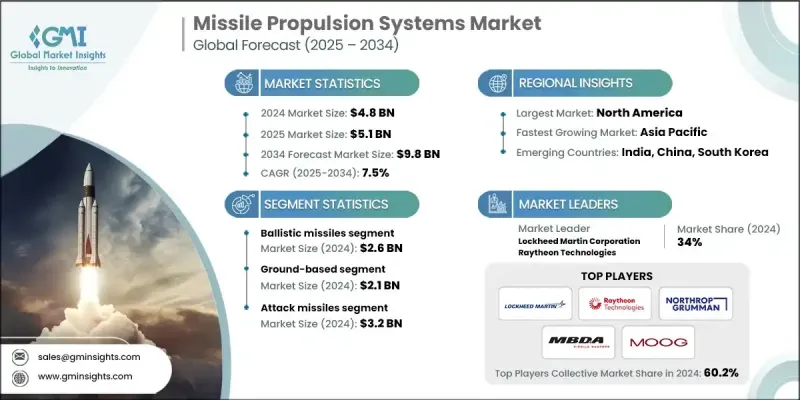
Several factors are contributing to this expansion, including increased global defense spending, rising geopolitical tensions, and a push for strategic military modernization. Additionally, the growing space exploration industry, coupled with the surge in satellite launches, is driving demand for advanced propulsion systems. As military technology advances, so does the need for high-performance propulsion solutions, particularly those that enable hypersonic speeds and high maneuverability. The integration of artificial intelligence (AI) and smart targeting systems is also reshaping missile technology, with military forces increasingly relying on AI to enhance precision and flexibility in missile strikes. This trend is expected to peak between 2025 and 2030, revolutionizing modern warfare with more accurate and adaptable missiles.
| Market Scope | |
|---|---|
| Start Year | 2024 |
| Forecast Year | 2025-2034 |
| Start Value | $4.8 Billion |
| Forecast Value | $9.8 Billion |
| CAGR | 7.5% |
The ballistic missile segment was valued at USD 2.6 billion in 2024. The segment benefits from the ongoing geopolitical instability, which increases the demand for long-range precision strike capabilities. Countries are investing heavily in upgrading their missile arsenals to ensure better speed, precision, and range. This calls for the development of advanced propulsion technologies that enhance fuel efficiency, modular flexibility, and precision strike capabilities.
The ground-based missile systems segment was valued at USD 2.1 billion in 2024, owing to the rising demand for mobile and deployable missile systems. With a greater focus on territorial defense and quick response capabilities, military forces are increasingly seeking advanced propulsion solutions to meet these needs. Manufacturers need to focus on enhancing mobility, improving propulsion efficiency, and creating advanced targeting systems to adapt to changing battlefield requirements.
U.S. Missile Propulsion Systems Market generated USD 1.5 billion in 2024 fueled by its substantial defense budget, which allows for significant investment in missile technology research and the development of hypersonic propulsion systems. The U.S. is also prioritizing the modernization of its military assets, which includes developing more advanced and efficient missile propulsion technologies. In line with this, manufacturers are working to accelerate innovations in hypersonic propulsion while forming strategic partnerships with defense agencies to address evolving technological demands.
Prominent companies in the Global Missile Propulsion Systems Industry include Lockheed Martin Corporation, Raytheon Technologies, Northrop Grumman, Rolls-Royce plc, Hanwha Aerospace, Kratos, Moog Inc., AVIO SPA, EDePRo, MBDA, IHI Corporation, Karman Space & Defense, Nammo AS, L3Harris Technologies, Inc., RAFAEL Advanced Defense Systems, Roxel, Vaya Space, and Walchandnagar Industries Limited. To maintain and strengthen their position in the missile propulsion systems market, companies are emphasizing cutting-edge technological advancements and strategic collaborations. Many are focusing on developing next-generation propulsion systems that incorporate hypersonic technology to meet military demands for speed and precision. Additionally, manufacturers are investing heavily in the integration of AI and smart systems to improve missile targeting and flexibility. Partnerships with defense agencies are also critical, allowing companies to remain closely aligned with military needs and benefit from government contracts.
Table of Contents
Chapter 1 Methodology and Scope
- 1.1 Market scope and definition
- 1.2 Research design
- 1.2.1 Research approach
- 1.2.2 Data collection methods
- 1.3 Data mining sources
- 1.3.1 Global
- 1.3.2 Regional/Country
- 1.4 Base estimates and calculations
- 1.4.1 Base year calculation
- 1.4.2 Key trends for market estimation
- 1.5 Primary research and validation
- 1.5.1 Primary sources
- 1.6 Forecast model
- 1.7 Research assumptions and limitations
Chapter 2 Executive Summary
- 2.1 Industry snapshot
- 2.2 Key market trends
- 2.2.1 Missile type trends
- 2.2.2 Propulsion type trends
- 2.2.3 Launch platform trends
- 2.2.4 Speed trends
- 2.2.5 Application trends
- 2.2.6 Regional
- 2.3 TAM Analysis, 2025-2034 (USD Million)
- 2.4 CXO perspectives: Strategic imperatives
- 2.4.1 Executive decision points
- 2.4.2 critical success factors
- 2.5 Future outlook and strategic recommendations
Chapter 3 Industry Insights
- 3.1 Industry ecosystem analysis
- 3.1.1 Supplier Landscape
- 3.1.2 Profit Margin
- 3.1.3 Cost structure
- 3.1.4 Value addition at each stage
- 3.1.5 Factor affecting the value chain
- 3.1.6 Disruptions
- 3.2 Industry impact forces
- 3.2.1 Growth drivers
- 3.2.1.1 Rising Global Defense Spending
- 3.2.1.2 Geopolitical Tensions & Strategic Modernization
- 3.2.1.3 Expansion of Space Exploration and Satellite Launch Activity
- 3.2.1.4 Advancements in Hypersonic Technology
- 3.2.1.5 Commercial Space Industry Expansion
- 3.2.2 Industry pitfalls and challenges
- 3.2.2.1 High Development and Procurement Costs
- 3.2.2.2 Stringent Export Regulations and Compliance Barriers
- 3.2.3 Market opportunities
- 3.2.3.1 Advancements in Green and Sustainable Propulsion Technologies
- 3.2.3.2 Emergence of Indigenous Defense Manufacturing
- 3.2.1 Growth drivers
- 3.3 Growth potential analysis
- 3.4 Regulatory landscape
- 3.4.1 North America
- 3.4.2 Europe
- 3.4.3 Asia Pacific
- 3.4.4 Latin America
- 3.4.5 Middle East & Africa
- 3.5 Porter’s analysis
- 3.6 PESTEL analysis
- 3.7 Technology and innovation landscape
- 3.7.1 Current technological trends
- 3.7.2 Emerging technologies
- 3.8 Emerging business models
- 3.9 Compliance requirements
- 3.10 Defense budget analysis
- 3.11 Global defense spending trends
- 3.12 Regional defense budget allocation
- 3.12.1 North America
- 3.12.2 Europe
- 3.12.3 Asia Pacific
- 3.12.4 Middle East and Africa
- 3.12.5 Latin America
- 3.13 Key defense modernization programs
- 3.14 Budget forecast (2025-2034)
- 3.14.1 Impact on Industry Growth
- 3.14.2 Defense Budgets by Country
- 3.15 Supply chain resilience
- 3.16 Geopolitical analysis
- 3.17 Workforce analysis
- 3.18 Digital transformation
- 3.19 Mergers, acquisitions, and strategic partnerships landscape
- 3.20 Risk assessment and management
- 3.21 Major contract awards (2021-2024)
Chapter 4 Competitive Landscape, 2024
- 4.1 Introduction
- 4.2 Company market share analysis
- 4.2.1 By region
- 4.2.1.1 North America
- 4.2.1.2 Europe
- 4.2.1.3 Asia Pacific
- 4.2.1.4 Latin America
- 4.2.1.5 Middle East & Africa
- 4.2.2 Market Concentration Analysis
- 4.2.1 By region
- 4.3 Competitive benchmarking of key players
- 4.3.1 Financial performance comparison
- 4.3.1.1 Revenue
- 4.3.1.2 Profit margin
- 4.3.1.3 R&D
- 4.3.2 Product portfolio comparison
- 4.3.2.1 Product range breadth
- 4.3.2.2 Technology
- 4.3.2.3 Innovation
- 4.3.3 Geographic presence comparison
- 4.3.3.1 Global footprint analysis
- 4.3.3.2 Service network coverage
- 4.3.3.3 Market penetration by region
- 4.3.4 Competitive positioning matrix
- 4.3.4.1 Leaders
- 4.3.4.2 Challengers
- 4.3.4.3 Followers
- 4.3.4.4 Niche players
- 4.3.5 Strategic outlook matrix
- 4.3.1 Financial performance comparison
- 4.4 Key developments, 2021-2024
- 4.4.1 Mergers and acquisitions
- 4.4.2 Partnerships and collaborations
- 4.4.3 Technological advancements
- 4.4.4 Expansion and investment strategies
- 4.4.5 Sustainability initiatives
- 4.4.6 Digital transformation initiatives
- 4.5 Emerging/ startup competitors landscape
Chapter 5 Market estimates and forecast, by Missile Type, 2021 - 2034 (USD Million)
- 5.1 Key trends
- 5.2 Ballistic missiles
- 5.2.1 Short range (<1,000 km)
- 5.2.2 Medium range (1,000-3,000 km)
- 5.2.3 Intermediate range (3,000-5,500 km)
- 5.2.4 Intercontinental range (>5,500 km)
- 5.3 Cruise missiles
- 5.3.1 Short range (<500 km)
- 5.3.2 Medium range (500-1,000 km)
- 5.3.3 Long range (1,000-3,000 km)
Chapter 6 Market estimates and forecast, by Propulsion Type, 2021 - 2034 (USD Million)
- 6.1 Key trends
- 6.2 Air-breathing
- 6.2.1 Gas turbine & jet engines
- 6.2.2 Ramjets & scramjets
- 6.3 Non-air-breathing
- 6.3.1 Solid propulsion
- 6.3.2 Liquid propulsion
- 6.3.3 Hybrid propulsion
- 6.3.4 Electric propulsion
Chapter 7 Market estimates and forecast, by Launch Platform, 2021 - 2034 (USD Million)
- 7.1 Key trends
- 7.2 Ground-based
- 7.3 Airborne
- 7.4 Naval
- 7.5 Space-enabled
Chapter 8 Market estimates and forecast, by Speed, 2021 - 2034 (USD Million)
- 8.1 Subsonic (< Mach 1)
- 8.2 Supersonic (Mach 1-5)
- 8.3 Hypersonic (> Mach 5)
Chapter 9 Market estimates and forecast, by Application, 2021 - 2034 (USD Million)
- 9.1 Attack Missiles
- 9.2 Defense Missiles
Chapter 10 Market estimates and forecast, by Region, 2021 - 2034 (USD Million)
- 10.1 Key trends
- 10.2 North America
- 10.2.1 U.S.
- 10.2.2 Canada
- 10.3 Europe
- 10.3.1 Germany
- 10.3.2 UK
- 10.3.3 France
- 10.3.4 Spain
- 10.3.5 Italy
- 10.3.6 Netherlands
- 10.4 Asia Pacific
- 10.4.1 China
- 10.4.2 India
- 10.4.3 Japan
- 10.4.4 Australia
- 10.4.5 South Korea
- 10.5 Latin America
- 10.5.1 Brazil
- 10.5.2 Mexico
- 10.5.3 Argentina
- 10.6 Middle East and Africa
- 10.6.1 Saudi Arabia
- 10.6.2 South Africa
- 10.6.3 UAE
Chapter 11 Company profiles
- 11.1 Global Key Players
- 11.1.1 Lockheed Martin Corporation
- 11.1.2 Raytheon Technologies
- 11.1.3 Northrop Grumman
- 11.1.4 MBDA
- 11.1.5. L3 Harris Technologies, Inc.
- 11.2 Regional Key Players
- 11.2.1 North America
- 11.2.1.1 Moog Inc.
- 11.2.1.2 Kratos
- 11.2.1.3 Karman Space & Defense .
- 11.2.2 Europe
- 11.2.2.1 AVIO SPA
- 11.2.2.2 Nammo AS
- 11.2.2.3 Roxel
- 11.2.2.4 Rolls-Royce plc
- 11.2.2.5 RAFAEL Advanced Defense Systems
- 11.2.2.6 EDePRo
- 11.2.3 Asia-Pacific
- 11.2.3.1 Hanwha Aerospace
- 11.2.3.2 IHI Corporation
- 11.2.3.3 Walchandnagar Industries Limited
- 11.2.1 North America
- 11.3 Disruptors / Niche Players
- 11.3.1 Vaya Space






